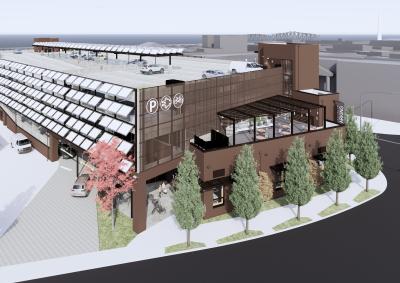

The Mount Vernon Library Commons in Washington State is an ambitious, multifaceted project that reflects the evolving nature of urban development, where sustainability, community integration, and economic growth are at the forefront. Located in the heart of downtown Mount Vernon, this transit-oriented development (TOD) is a keystone in the city’s future and a pioneering initiative in the broader Cascadia Innovation Corridor that stretches between Seattle and Vancouver, BC.
With a total project cost of $53 million, the Library Commons addresses various community needs while making significant strides in sustainability, public transportation, and EV infrastructure.
The Mount Vernon Library Commons is built with a focus on transit-oriented development. It is designed to maximize access to public transportation while reducing the dependence on private vehicles. As the first TOD project to receive a Transportation Infrastructure Finance and Innovation Act (TIFIA) loan from the U.S. Department of Transportation, the Library Commons sets a precedent for future projects that aim to integrate sustainability with urban functionality.
Positioned near Interstate 5 and within walking distance of the Skagit Transit Station, the Commons enhances local mobility and serves as a regional connector between major urban centers. The TOD model encourages public transportation, reduces traffic congestion, and minimizes the environmental impact associated with car-dependent development. Moreover, the project boosts local economic development, reinforcing the area's strategic importance within the Cascadia corridor.
A defining feature of the Mount Vernon Library Commons is its commitment to EV infrastructure. The project will install 76 EV charging stations, with provisions to scale up to 200 stations, making it the largest public EV charging site in the United States. Including four DC fast chargers (DCFC) and infrastructure to accommodate four more DCFCs further underscores its forward-thinking design.
Transportation remains one of the largest sources of greenhouse gas emissions in the United States, and the widespread adoption of electric vehicles is critical for meeting national and global climate targets. The Environmental Protection Agency (EPA) reports that electric vehicles produce 60-90% fewer carbon emissions than traditional gasoline-powered vehicles. By providing the country's largest public EV charging facility, the Library Commons project encourages the adoption of electric vehicles and directly contributes to reducing Mount Vernon’s carbon footprint.
While the Library Commons project is a vital transportation infrastructure, it also serves as a community hub, providing services beyond transit. The complex will house a public library as a modern, equitable institution for lifelong learning, digital literacy, and civic engagement.
The library’s resources are expected to benefit various population segments, including seniors, students, and aspiring entrepreneurs. As a business incubation and workforce development center, the library will also offer training programs to foster new economic opportunities.
In addition to the library, the Commons will include a young adult STEM center designed to inspire and educate future generations in science, technology, engineering, and math. This educational hub will prepare young people for careers in an increasingly tech-driven economy. The facility will also feature a commercial kitchen available for community use, a conference center for local events and gatherings, and a park-and-ride facility, all catering to the diverse needs of the Mount Vernon population.
The project is designed to follow Passive House standards, recognized as one of the world’s most stringent energy efficiency protocols. Due to their super insulation, airtight construction, and high-performance windows, Passive House buildings consume up to 80% less energy than traditional structures. These features dramatically reduce the energy required for heating and cooling, lowering the building’s overall carbon footprint.
In addition to its energy-efficient design, the Library Commons also incorporates significant advancements in materials engineering. The concrete used in construction has a 40% reduction in Global Warming Potential (GWP) compared to conventional concrete mixes. This reduction is achieved by altering the mix of materials to include lower-carbon alternatives, thus lowering the emissions produced during construction.
Additionally, the building will feature a 112,000 kW solar array installed on the south elevation. This solar array will generate renewable energy on-site, contributing to the building’s energy needs and potentially feeding excess power back into the grid.
The $53 million project is funded through local, state, and federal sources, including a $26.8 million TIFIA loan. This loan is significant not only because it marks the first time a transit-oriented development has received TIFIA funding but also because it saved the city of Mount Vernon approximately $3 million. The loan’s terms allow for a lower cost of borrowing, making it easier for the city to invest in sustainable infrastructure.
In addition to the TIFIA loan, the project received a $12.5 million grant from President Biden’s Bipartisan Infrastructure Law. This federal support reflects a growing national commitment to investing in green infrastructure, public transportation, and community development. Additional funding of $3 million came from the 2024 annual transportation budget, following advocacy efforts by U.S. Senator Maria Cantwell.
As Mount Vernon looks to the future, the Library Commons project offers a model for other cities across the United States. It demonstrates that community-oriented development can be both economically viable and environmentally responsible.
As more communities look for ways to mitigate the effects of climate change, the lessons learned from this project will likely shape the next generation of urban development projects nationwide.